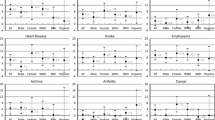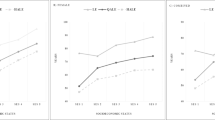Abstract
Purpose
Quality-Adjusted Life Expectancy (QALE) is a summary measure of mortality and health-related quality of life (HRQOL) across different stages of life. This study developed a method to calculate state-level QALE for U.S. adults.
Methods
Population HRQOL data came from the Behavioral Risk Factor Surveillance System (BRFSS). Using age-specific deaths from the Mortality Summary File, this study constructed life tables to estimate life expectancy and QALE for all 50 States and the District of Columbia by sex and race from 1993 through 2008.
Results
From 1993 to 2008, the QALE of an U.S. adult at 18 years old had increased from 51.2 to 52.3 years. In 2006, states with the highest QALE were Hawaii (56.2), Minnesota (55.2), North Dakota (54.9), Iowa (54.7), and Nebraska (54.4), while the states with the lowest QALE were West Virginia (47.1), Mississippi (48.2), Alabama (48.5), Kentucky (48.5), and Oklahoma (49.0).
Conclusions
Because population HRQOL values and mortality statistics are available from existing and publicly accessible data and because formulas for the calculation of QALE and its standard error are easy to incorporate in a spreadsheet, State and local Health Departments can calculate QALE as a routine surveillance measurement for tracking their population’s health over time.


Similar content being viewed by others
Abbreviations
- QALE:
-
Quality-Adjusted Life Expectancy
- HRQOL:
-
Health-Related Quality of Life
- QALYs:
-
Quality-Adjusted Life Years
- CDC:
-
The U.S. Centers for Disease Control and Prevention
- NCHS:
-
The National Center for Health Statistics
- BRFSS:
-
The Behavioral Risk Factor Surveillance System
- MEPS:
-
The Medical Expenditure Panel Survey
References
George, M. G., Tong, X., McGruder, H., Yoon, P., Rosamond, W., Winquist, A., et al. (2009). Centers for disease control and prevention (CDC). Paul Coverdell National Acute Stroke Registry Surveillance—four states, 2005–2007. MMWR. Surveillance Summaries, 58(7), 1–23.
Karch, D. L., Dahlberg, L. L., & Patel, N. (2010). Surveillance for violent deaths—National violent death reporting system, 16 States, 2007. MMWR. Surveillance Summaries, 59(4), 1–50.
The Secretary’s Advisory Committee on National Health Promotion and Disease Prevention Objectives for 2020. (2008). Phase I Report: Recommendations for the Framework and Format of Healthy People 2020. http://www.healthypeople.gov/hp2020/advisory/PhaseI/PhaseI.pdf. Accessed 23 August, 2010.
Gold, M. R., Siegel, J. E., Russell, R. B., & Weinstein, M. C. (1996). Cost-effectiveness in health and medicine. New York: Oxford University Press.
Chiang, C. L. (1984). Statistical inference regarding life table functions. In C. L. Chiang (Ed.), The life table and its applications (pp. 153–167). Malabar, FL: Robert E. Krieger Publishers.
Shryock, H. S., Siegel, J. S., & Associates. (1976). The Methods and Materials of Demographics (edited by E. G. Stockwell). San Diego, CA: Academic Press.
Rosenberg, M. A., Fryback, D. G., & Lawrence, W. F. (1999). Computing population-based estimates of health-adjusted life expectancy. Medical Decision Making, 19, 90–97.
Jia, H., & Lubetkin, E. I. (2009). The statewide burden of obesity, smoking, low income and chronic diseases in the United States. Journal of Public Health (Oxf), 31(4), 496–505.
US Centers for Disease Control and Prevention (CDC), National Center for Chronic Disease Prevention and Health Promotion, Division of Adult and Community Health (DACH). (2008). Summary of the Health-Related Quality of Life (HRQOL). Atlanta, GA: Surveillance Expert Panel.
Frazier, E. L., Franks, A. L., & Sanderson, L. M. (1992). Using behavioral risk factor surveillance data. In Using chronic disease data: A handbook for public health practitioners (pp. 4.1–4.17). Atlanta GA: Centers for Disease Control and Prevention.
Mokdad, A. H., Stroup, D. F., & Giles, W. H.; Behavioral Risk Factor Surveillance Team. (2003). Public health surveillance for behavioral risk factors in a changing environment. Recommendations from the Behavioral Risk Factor Surveillance Team. MMWR Recommendation Report, 52(RR–9), 1–12.
Centers for Disease Control and Prevention. (2000). Measuring Healthy Days: Population Assessment of Health-Related Quality of Life. U.S. Department of Health and Human Services. Centers for Disease Control and Prevention. National Center for Chronic Disease Prevention and Health Promotion. Division of Adult and Community Health.
Jia, H., Lubetkin, E. I., Moriarty, D. G., & Zack, M. M. (2007). A comparison of healthy days and EuroQol EQ-5D measures in two US adult samples. Applied Research in Quality of Life, 2, 209–221.
Jia, H., & Lubetkin, E. I. (2008). Estimating EuroQol EQ-5D scores from population healthy days data. Medical Decision Making, 28(4), 491–499.
Jia, H., Zack, M. M., Moriarty, D. G., & Fryback, D. G. (2010). Predicting the EuroQol Group’s EQ-5D index from CDC’s “Healthy Days” in a US sample. Medical Decision Making. doi:10.1177/0272989X10364845.
Fryback, D. G., Dunham, N. C., Palta, M., Hanmer, J., Buechner, J., Cherepanov, D., et al. (2009). US norms for six generic health-related quality-of-life indexes from the national health measurement study. Medical Care, 45(12), 1162–1170.
Fryback, D. G., Palta, M., Cherepanov, D., Bolt, D., & Kim, J. S. (2010). Comparison of 5 health-related quality-of-life indexes using item response theory analysis. Medical Decision Making, 30(1), 5–15. Epub 2009 Oct 20.
Anderson, R. N. (1999). Method for constructing complete annual U.S. life tables. National Center for Health Statistics. Vital Health Statistics, 2(129).
Silcocks, P. B. S., & Reza, D. A. J. (2001). Life expectancy as a summary of mortality in a population: Statistical considerations and suitability for use by health authorities. Journal of Epidemiology and Community Health, 55, 38–43.
Brocklebank, J. C., & Dickey, D. A. (2003). SAS for forecasting time series (2nd ed.). Cary, NC: SAS Institute Inc.
Zack, M. M., Moriarty, D. G., Stroup, D. F., Ford, E. S., & Mokdad, A. H. (2004). Worsening trends in adult health-related quality of life and self-rated health-United States, 1993–2001. Public Health Reports, 119(5), 493–505.
Jia, H., Muennig, P., & Borawski, E. (2004). Comparison of small area analysis techniques for estimating county-level outcomes. American Journal of Preventive Medicine, 26(5), 453–460.
Muennig, P., Franks, P., Jia, H., Lubetkin, E., & Gold, M. R. (2005). The income-associated burden of disease in the United States. Social Science and Medicine, 61, 2018–2026.
Muennig, P., Lubetkin, E., Jia, H., & Franks, P. (2006). Gender and the burden of disease attributable to obesity. American Journal of Public Health, 96, 1662–1668.
Jia, H., & Lubetkin, E. I. (2010). Trends in quality-adjusted life-years lost contributed by smoking and obesity. American Journal of Preventive Medicine, 38(2), 138–140.
Brazier, J., Roberts, J., & Deverill, M. (2002). The estimation of a preference-based measure of health from the SF-36. Journal of Health Economics, 21, 271–292.
Acknowledgments
This study (HJ) is supported by a CDC contract (No. 200-2009-M-32247).
Author information
Authors and Affiliations
Corresponding author
Additional information
The findings and conclusions in this article are those of the authors and do not necessarily represent the official position of the Centers for Disease Control and Prevention.
Rights and permissions
About this article
Cite this article
Jia, H., Zack, M.M. & Thompson, W.W. State Quality-Adjusted Life Expectancy for U.S. adults from 1993 to 2008. Qual Life Res 20, 853–863 (2011). https://doi.org/10.1007/s11136-010-9826-y
Accepted:
Published:
Issue Date:
DOI: https://doi.org/10.1007/s11136-010-9826-y




